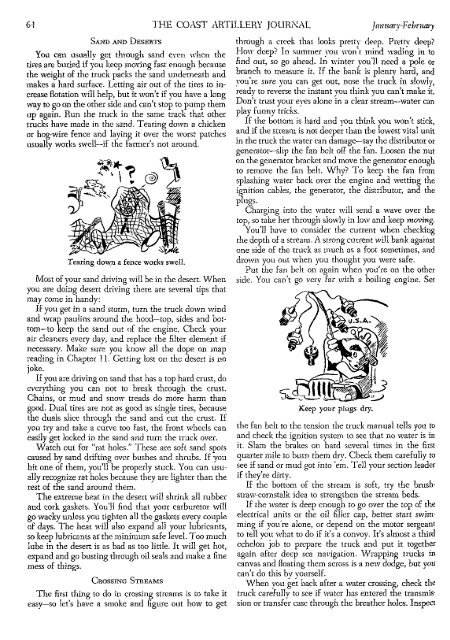January-February - Air Defense Artillery
January-February - Air Defense Artillery
January-February - Air Defense Artillery
Create successful ePaper yourself
Turn your PDF publications into a flip-book with our unique Google optimized e-Paper software.
64<br />
SAND AND DESElrrs<br />
You can usually get through sand eyen when the<br />
tires are buried if you keep moving fast enough because<br />
the weight of the truck packs the sand underneath and<br />
makes a hard surface. Letting air out of the tires to increase<br />
flotation will help, but it won't if you have a long<br />
way to go on the other side and can't stop to pump them<br />
up again. Run the truck in the same track that other<br />
trucks have made in the sand. Tearing down a chicken<br />
or hog-wire fence and laying it over the 'worst patches<br />
usually works swell-if the farmer's not around.<br />
Tearing do~n a fence works swell.<br />
THE COAST ARTILLERY JOUR~AL<br />
Most of your sand driving will be in the desert. When<br />
you are doing desert driving there are several tips that<br />
may come in handy:<br />
If you get in a sand storm, turn the truck down wind<br />
and wrap paulins around the hood-top, sides and bottom-to<br />
keep the sand out of the engine. Check your<br />
air cleaners every day, and replace the filter element if<br />
necessary. Make sure you know all the dope on map<br />
reading in Chapter 11. Getting lost on the desert is no<br />
joke.<br />
If you are driving on sand that has a top hard crust, do<br />
everything you can not to break through the crust.<br />
Chains, or mud and snow treads do more harm than<br />
good. Dual tires are not as good as single tires, because<br />
the duals slice through the sand and cut the crust. If<br />
you try and take a curve too fast, the front wheels can<br />
easily get locked in the sand and turn the truck over.<br />
Watch out for "rat holes." These are soft sand spots<br />
caused by sand drifting over bushes and shrubs. If you<br />
hit one of them, you'll be properly stuck. You can usually<br />
recognize rat holes because they are lighter than the<br />
rest of the sand around them.<br />
The extreme heat in the desert will shrink all rubber<br />
and cork gaskets. You'll find that your carburetor vvill<br />
go wacky unless you tighten all the gaskets every couple<br />
of days. The heat will also expand all your lubricants,<br />
so keep lubricants af the minimum safe level. Too much<br />
lube in the desert is as bad as too little. It will get hot,<br />
expand and go busting through oil seals and make a fine<br />
mess of things.<br />
CROSSING STREAMS<br />
The first thing to do in crossing streams is to take it<br />
easy-so let's have a smoke and figure out how to get<br />
Tmmarl'-Fehruary<br />
.. -<br />
through a creek that looks pretty deep. Pretty deep?<br />
How deep? In summer you won't mind wading in to<br />
find out, so go ahead. In winter you'll need a pole or<br />
braI?ch to measure it. If the bank is plenty hard, and<br />
you re sure you can get out, nose the truck in slowly,<br />
ready to reverse the instant you think you can't make it.<br />
Don't trust your eyes alone in a clear ~tream-water can<br />
play funny tricks.<br />
If the bottom is hard and you think you won't stick,<br />
and if the stream is not deeper than the lowest vital unit<br />
in the truck the water can damage-say the distributor or<br />
generator-slip the fan belt off the fan. Loosen the nut<br />
on the generator bracket and move the generator enough<br />
to remove the fan belt. Why? To keep the fan from<br />
splashing ,"vaterback over the engine and wetting the<br />
ignition cables, the generator, the distributor, and the<br />
plugs.<br />
Charging into the water will send a wave over the<br />
top, so take her through slowly in low and keep moving.<br />
You'll have to consider the current when checking<br />
the depth of a stream. A strong current will bank against<br />
one side of the truck as much as a foot sometimes, and<br />
drmvn you out when you thought you were safe.<br />
Put the fan belt on again when you're on the other<br />
side. You can't go very far with a boiling engine. Set<br />
the fan belt to the tension the truck manual tells you to<br />
and check the ignition system to see that no water is in<br />
it. Slam the brakes on hard several times in the first<br />
quarter mile to burn them dry. Check them carefully to<br />
see if sand or mud got into 'em. Tell your section leader<br />
if they're dirty.<br />
If the bottom of the stream is soft, try the brushstraw-cornstalk<br />
idea to strengthen the stream beds.<br />
If the water is deep enough to go over the top of the<br />
electrical units or the oil filler cap, better start swimming<br />
if you're alone, or depend on the motor sergeant<br />
to tell vou what to do if it's a convov. It's almost a third<br />
echeJo~ job to prepare the truck ~nd put it together<br />
again after deep sea navigation. \i\1rapping trucks in<br />
canvas and floating them across is a new dodge, but you<br />
can't do this bv yourself.<br />
When you get back after a water crossing, check the<br />
truck carefully to see if water has entered the transmission<br />
or transf~r case through the breather holes. Inspect
















